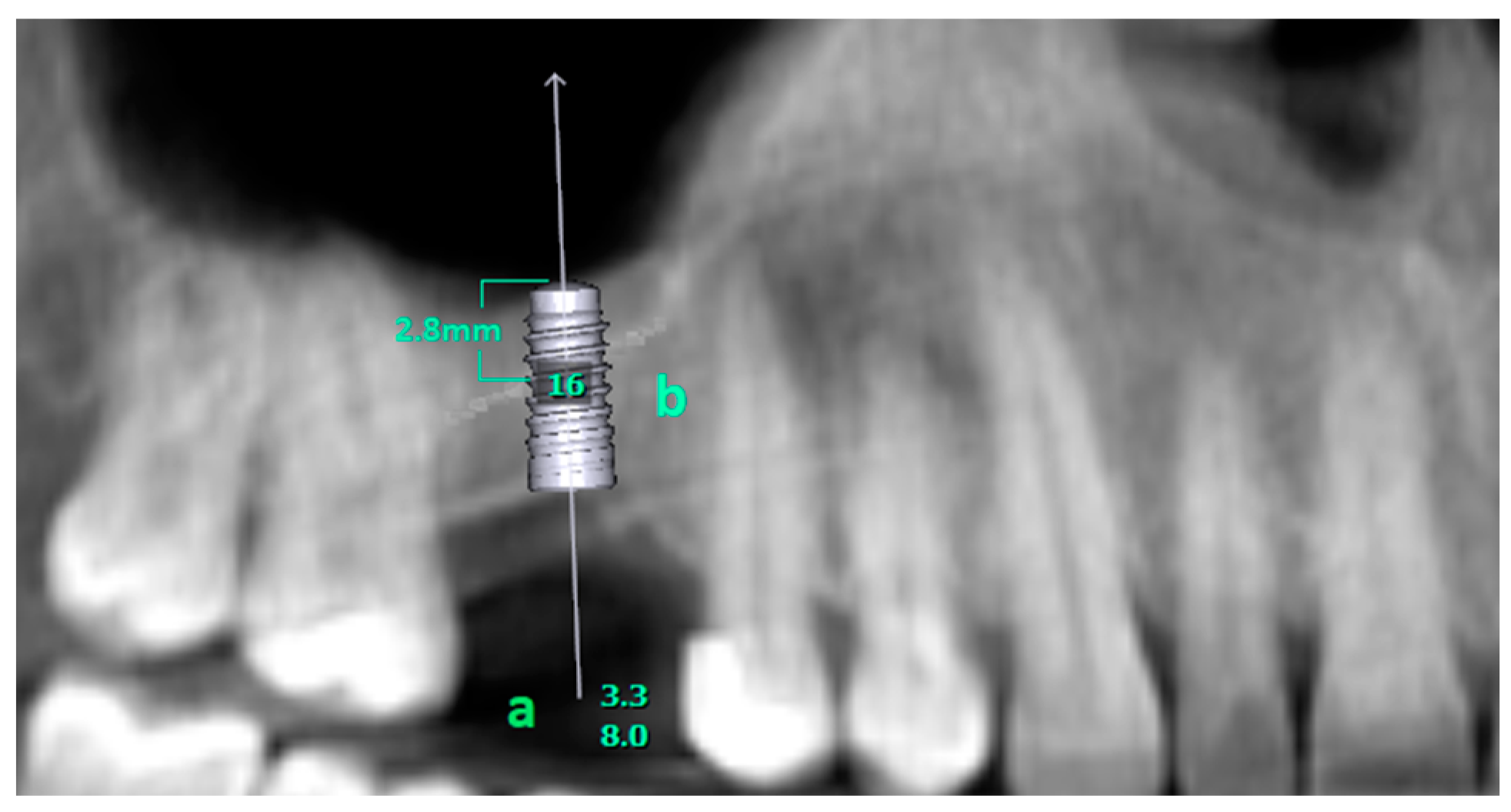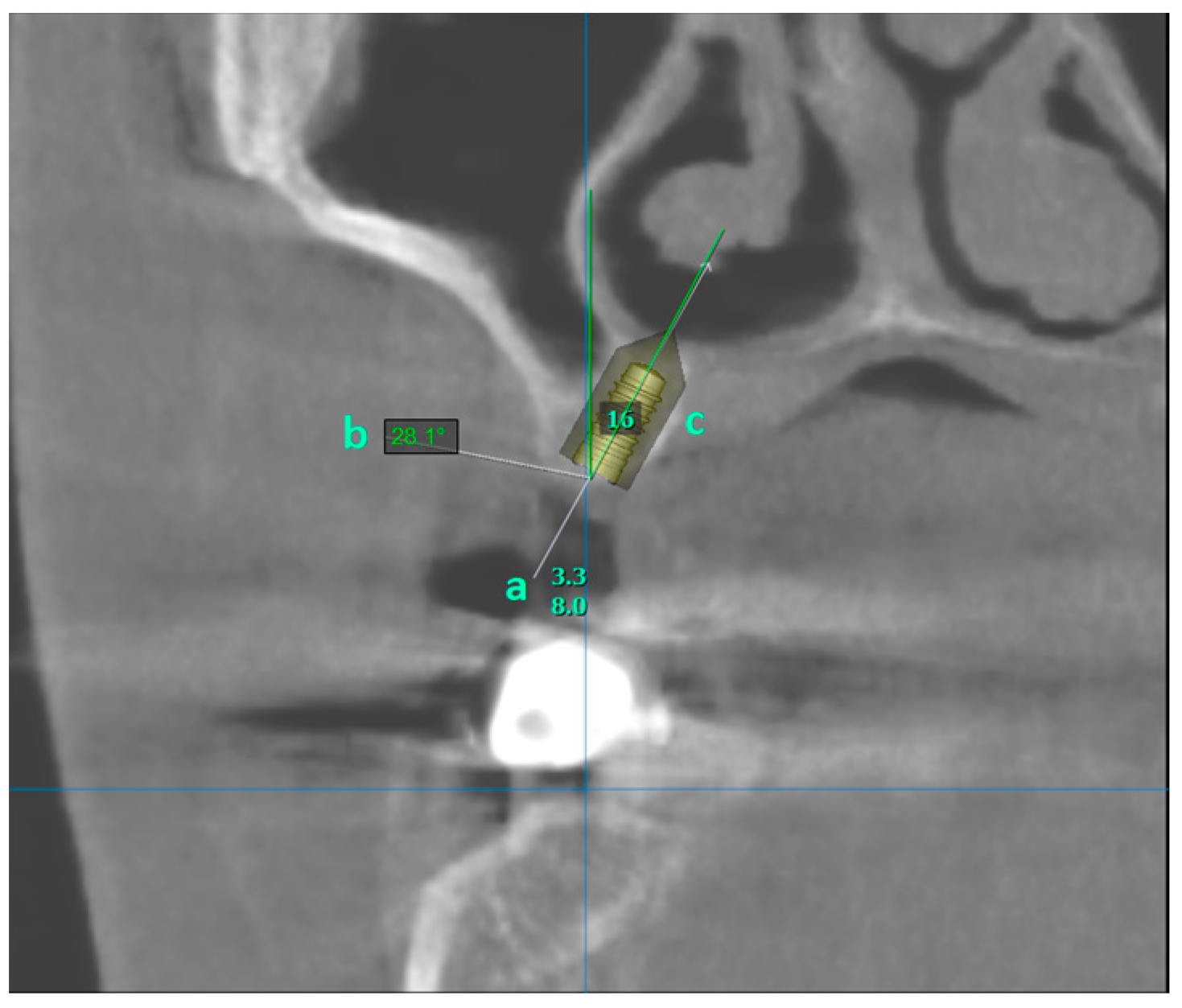Avoiding Sinus Floor Elevation by Placing a Palatally Angled Implant: A Morphological Study Using Cross-Sectional Analysis Determined by CBCT
Abstract
:1. Introduction
2. Materials and Methods
Statistical Analysis
3. Results
4. Discussion
5. Conclusions
Author Contributions
Funding
Institutional Review Board Statement
Informed Consent Statement
Data Availability Statement
Acknowledgments
Conflicts of Interest
References
- Molina, A.; Sanz-Sánchez, I.; Sanz-Martín, I.; Ortiz-Vigón, A.; Sanz, M. Complications in sinus lifting procedures: Classification and management. Periodontology 2000 2022, 88, 103–115. [Google Scholar] [CrossRef]
- Proussaefs, P.; Lozada, J.; Kim, J.; Rohrer, M.D. Repair of the perforated sinus membrane with a resorbable collagen membrane: A human study. Int. J. Oral Maxillofac. Implant. 2004, 19, 413–420. [Google Scholar]
- Hu, Y.-K.; Qian, W.-T.; Xu, G.-Z.; Zou, D.-H.; Yang, C. A Study of Two Novel Techniques for One-stage Closure of Chronic Oroantral Fistula and Sinus Floor Lift. J. Craniofac. Surg. 2023, 34, 1799–1803. [Google Scholar] [CrossRef] [PubMed]
- Ata-Ali, J.; Diago-Vilalta, J.V.; Melo, M.; Bagan, L.; Soldini, M.; Di-Nardo, C.; Ata-Ali, F.; Mañes-Ferrer, J. What is the frequency of anatomical variations and pathological findings in maxillary sinuses among patients subjected to maxillofacial cone beam computed tomography? A systematic review. Med. Oral Patol. Oral Cir. Bucal 2017, 22, e400–e409. [Google Scholar] [CrossRef] [PubMed]
- Ashley, D. The man behind the success of all on four dental implants. U Publish.Info 2011, 2011, 1. [Google Scholar]
- Asawa, N.; Bulbule, N.; Kakade, D.; Shah, R. Angulated Implants: An Alternative to Bone Augmentation and Sinus Lift Procedure: Systematic Review. J. Clin. Diagn. Res. 2015, 9, Ze10-3. [Google Scholar] [CrossRef] [PubMed]
- Lim, T.J.; Csillag, A.; Irinakis, T.; Nokiani, A.; Wiebe, C.B. Intentional angulation of an implant to avoid a pneumatized maxillary sinus: A case report. J. Can. Dent. Assoc. 2004, 70, 164–168. [Google Scholar] [PubMed]
- Bilhan, H. An Alternative Method to Treat a Case with Severe Maxillary Atrophy by the Use of Angled Implants Instead of Complicated Augmentation Procedures: A Case Report. J. Oral Implant. 2008, 34, 47–51. [Google Scholar] [CrossRef]
- Zampelis, A.; Rangert, B.; Heijl, L. Tilting of splinted implants for improved prosthodontic support: A two-dimensional finite element analysis. J. Prosthet. Dent. 2007, 97 (Suppl. 6), S35–S43. [Google Scholar] [CrossRef]
- Esposito, M.; Felice, P.; Worthington, H.V. Interventions for replacing missing teeth: Augmentation procedures of the maxillary sinus. Cochrane Database Syst. Rev. 2014, 2014, Cd008397. [Google Scholar] [CrossRef]
- Wallace, S.S.; Froum, S.J. Effect of Maxillary Sinus Augmentation on the Survival of Endosseous Dental Implants. A Systematic Review. Ann. Periodontol. 2003, 8, 328–343. [Google Scholar] [CrossRef]
- Aghaloo, T.L.; Moy, P.K. Which hard tissue augmentation techniques are the most successful in furnishing bony support for implant placement? Int. J. Oral Maxillofac. Implant. 2007, 22, 49–70. [Google Scholar]
- Avila-Ortiz, G.; Bartold, P.; Giannobile, W.; Katagiri, W.; Nares, S.; Rios, H.; Spagnoli, D.; Wikesjö, U. Biologics and Cell Therapy Tissue Engineering Approaches for the Management of the Edentulous Maxilla: A Systematic Review. Int. J. Oral Maxillofac. Implant. 2016, 31, s121–s164. [Google Scholar] [CrossRef] [PubMed]
- Del Fabbro, M.; Wallace, S.; Testori, T. Long-Term Implant Survival in the Grafted Maxillary Sinus: A Systematic Review. Int. J. Periodontics Restor. Dent. 2013, 33, 773–783. [Google Scholar] [CrossRef] [PubMed]
- Moraschini, V.; Uzeda, M.; Sartoretto, S.; Maia, C. Maxillary sinus floor elevation with simultaneous implant placement without grafting materials: A systematic review and meta-analysis. Int. J. Oral Maxillofac. Surg. 2017, 46, 636–647. [Google Scholar] [CrossRef] [PubMed]
- Lim, H.-C.; Kim, S.; Kim, D.-H.; Herr, Y.; Chung, J.-H.; Shin, S.-I. Factors affecting maxillary sinus pneumatization following posterior maxillary tooth extraction. J. Periodontal Implant. Sci. 2021, 51, 285–295. [Google Scholar] [CrossRef]
- Yücesoy, T.; Göktaş, T. Evaluation of Sinus Pneumatization and Dental Implant Placement in Atrophic Maxillary Premolar and Molar Regions. Int. J. Oral Maxillofac. Implant. 2022, 37, 407–415. [Google Scholar] [CrossRef]
- Nulty, A. A literature review on prosthetically designed guided implant placement and the factors influencing dental implant success. Br. Dent. J. 2024, 236, 169–180. [Google Scholar] [CrossRef] [PubMed]
- Atieh, M.A.; Shah, M.; Ameen, M.; Tawse-Smith, A.; Alsabeeha, N.H.M. Influence of implant restorative emergence angle and contour on peri-implant marginal bone loss: A systematic review and meta-analysis. Clin. Implant. Dent. Relat. Res. 2023, 25, 840–852. [Google Scholar] [CrossRef] [PubMed]
- Gümrükçü, Z.; Korkmaz, Y.T.; Korkmaz, F.M. Biomechanical evaluation of implant-supported prosthesis with various tilting implant angles and bone types in atrophic maxilla: A finite element study. Comput. Biol. Med. 2017, 86, 47–54. [Google Scholar] [CrossRef] [PubMed]
- Saini, S.; Meena, A.; Yadav, R.; Patnaik, A. Fabrication, Evaluation, and Performance Ranking of Tri-calcium Phosphate and Silica Reinforced Dental Resin Composite Materials. Silicon 2023, 15, 8045–8063. [Google Scholar] [CrossRef]


| Mean | Standard Deviation | ||
| Age | 50.45 | 13.97 | |
| n | Percentage | ||
| Gender | Male | 40 | 40% |
| Female | 60 | 60% | |
| Age | |||||
|---|---|---|---|---|---|
| Mean | Standard Deviation | t | p | ||
| Gender | Male | 48.88 | 13.63 | −0.926 | 0.357 |
| Female | 51.53 | 14.20 | |||
| Region | Measurement | Count | Percentage | Available | Not Available | ||
|---|---|---|---|---|---|---|---|
| n | Percentage | n | Percentage | ||||
| Second Molar | Edentulous | 28 | 14% | 11 | 39.3% | 17 | 60.7% |
| Dentulous | 172 | 86% | |||||
| First Molar | Edentulous | 38 | 19% | 24 | 63.1% | 14 | 26.9% |
| Dentulous | 162 | 81% | |||||
| Second Premolar | Edentulous | 14 | 7% | 11 | 78.5% | 3 | 21.5% |
| Dentulous | 186 | 93% | |||||
| Region | Available | Not Available | X2 | p | ||
|---|---|---|---|---|---|---|
| n | Percentage | n | Percentage | |||
| Second Molar | 11 | 39.3% | 17 | 60.7% | 6.843 | 0.033 |
| First Molar | 24 | 63.1% | 14 | 26.9% | ||
| Second Premolar | 11 | 78.5% | 3 | 21.5% | ||
| Region | Available | Not Available | z | p | ||
|---|---|---|---|---|---|---|
| n | Percentage | n | Percentage | |||
| Second Molar | 11 | 39.3% | 17 | 60.7% | −2.83 | 0.005 |
| First Molar | 24 | 63.1% | 14 | 26.9% | 3.68 | <0.001 |
| Second Premolar | 11 | 78.5% | 3 | 21.5% | 7.92 | <0.001 |
Disclaimer/Publisher’s Note: The statements, opinions and data contained in all publications are solely those of the individual author(s) and contributor(s) and not of MDPI and/or the editor(s). MDPI and/or the editor(s) disclaim responsibility for any injury to people or property resulting from any ideas, methods, instructions or products referred to in the content. |
© 2024 by the authors. Licensee MDPI, Basel, Switzerland. This article is an open access article distributed under the terms and conditions of the Creative Commons Attribution (CC BY) license (https://creativecommons.org/licenses/by/4.0/).
Share and Cite
Kaya, D.I.; Şatır, S.; Öztaş, B.; Yıldırım, H. Avoiding Sinus Floor Elevation by Placing a Palatally Angled Implant: A Morphological Study Using Cross-Sectional Analysis Determined by CBCT. Diagnostics 2024, 14, 1242. https://doi.org/10.3390/diagnostics14121242
Kaya DI, Şatır S, Öztaş B, Yıldırım H. Avoiding Sinus Floor Elevation by Placing a Palatally Angled Implant: A Morphological Study Using Cross-Sectional Analysis Determined by CBCT. Diagnostics. 2024; 14(12):1242. https://doi.org/10.3390/diagnostics14121242
Chicago/Turabian StyleKaya, Doğan Ilgaz, Samed Şatır, Beyza Öztaş, and Hasan Yıldırım. 2024. "Avoiding Sinus Floor Elevation by Placing a Palatally Angled Implant: A Morphological Study Using Cross-Sectional Analysis Determined by CBCT" Diagnostics 14, no. 12: 1242. https://doi.org/10.3390/diagnostics14121242






